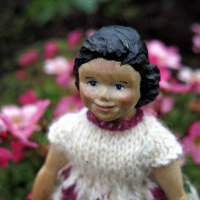Lessons From a Dumpster Dive
Last week as I was running errands in town, I noticed giant sample books sticking out of the trash can at an interior decorator’s shop. I gathered up my nerve and went in and asked if she would mind if I took them. She was happy to give them to me and even helped me load them in the truck!
I had no idea what kind of samples were in the books, but one of my quilting friends runs a Girl Scout troop and they can always use art supplies. Last month she made little worry dolls with the girls, and I thought maybe these samples could become blankets or rugs for worry doll shoe box houses.
It turned out these samples were for window coverings, and the more I went through the boxes, the more amazed I became. So much thought went into the product presentation — not only to make the product attractive to customers, but to make the samples organized, informative, and long-lasting.
The boxes themselves are covered in interesting fabrics, with magnets keeping them closed. The handles look like they belong on purses, and the little chain holding the logo tags even has a lobster clasp, like a nice bracelet.
Then you get into the actual samples. Every color of every product is represented!
What really struck me most was the organization. Every sample has an information label, every product has a section header with size and content info, and every single thing is labeled with where it belongs in the sample box! Most of the information is for the customer, but there is also information for the interior decorator, about displaying and re-storing the samples.
A few years ago, I saw how much work goes into simple paint chip cards on How It’s Made —
and that gave me a clue as to the number of decisions and processes that must have gone into making these elaborate sample boxes.
My own work is much less structured. I have followed the example of the Greek potters that I learned about a few years ago, and tried to just go ahead and get a piece finished with the idea of the moment and the materials I have on hand.
My usual routine is to choose a cute pattern from my files, and then amend it to fit whatever material I have on hand. I might see a pattern for a quilt of fall leaves, made in silk, and change it around to make a quilt of daisies made out of pink polka dot cotton. I feel like I have accomplished a well-thought-out project when I have completed four steps – cutting, piecing, quilting, binding. If I was really on a roll, I might embellish with some beads or buttons.
But seeing the amount of planning and design in these sample boxes made me think about the opposite approach — what would it be like, if just once, I planned a project down to the nuances of hardware choices, fonts, and labels?
I don’t know if I ever will, but it’s something to think about.





















J > Thank you so much for sharing this with us – your re-discovery and exploring of Detail as Art. The greater attention to detail, the more we learn, the more our skills develop, the more mature and sophististicated our views … and the more difficult it is to be spontaneous and creative. The mistake made by many is to spurn detail entirely – as if it were the antithesis of what it means to be creative: they are the losers. Yes, the details do matter – and sometimes they come first, not last. A watercolourist – howsoever talented he or she may be – must understand how much margin to leave for signature, mounting and framing, even before putting brush to paper.
You’re right, it’s a continuum from being so perfectionist you’re afraid to make anything, and being so slapdash that no one can tell what your creative effort is meant to be!
If I were making things to enter in shows, I would think my projects out more carefully. But as I am usually just making “day-brighteners”, I don’t let the perfect get in the way of the finished! 🙂 But I think I would like to make one or two heirloom-type projects where I considered all the details and added more levels of interest than I usually do.
I recall reading about Salvador Dali and the amount of time he spent learning how to draw. You have to have the rudiments, as Ginger Baker once said. ( Top notch drummer with the Cream), before you can be creative!
That’s true, and I think there is also a skill in leading your audience from the rudiments into your realm of creativity! You might have to go carefully at first so they can see the new direction you are taking them into, art- or music-wise.
This is a great post and such a thought-provoking idea.
I have a similar experience in Italy as the attention to detail always astounds me, right down to the way that purchases are packaged and the way that clothes are folded, pressed and cared for. It always opens my casual North American eyes!
I like that, “casual North American eyes.” Maybe it’s because I learned to weave in the 70s when everything was big drippy ropes, and just the tag “handmade” was enough to elicit people’s admiration. You kind of feel like, I made it by hand, I don’t have to do anything special on top of that. I am one to look back longingly at the details and quality of fashion from about 1965 and before, but it doesn’t occur to me to put in the work to make those beautiful things for myself! (as you do) But these sample books made me think about at least adding one special detail to each project.
In northeast Ohio a recycling organization collects discarded samples of all kinds from decorators and architects and offers them first come/first served once a year to the general public. This year this was so popular that a friend who went 2 hours after the give away opened found everything was already gone.
That would be a great thing to do! The county I live in now has next to no efforts to recycle anything, and that is very disappointing. The 2 counties we were in previously are much better.
Sample books……I was given HUNDREDS of pounds of curtain/upholstery you name it samples and I sewed clutch purses/wine bottle packages/shoulder bags/Big bags for portfolios/Christmas stockings and who knows what else………….. all for an art teacher to hopefully sell at a Christmas Fair to make $ for her class to buy art supplies. You do get lost in all the colours………Got stupefied after a while and needed help matching things! LOL
Wow! I am not going to sew hundreds of anything, but those wine bottle bags sound like a good idea!
I hope the teacher appreciated you!
You hit the mother lode! I am pretty loosey-goosey about planning projects but am trying to get better about documenting what I did afterward, especially with weaving. I know I’m never going to make the same quilt twice but I may very well want to reproduce a scarf or towel.
I am trying to remember to document as I go. I always think,”Well, I’ll pick up and work on this more tomorrow,” but then something happens and a month goes by, and I come back to it and think, “What on earth was I doing?”
Ha-ha. Even if I plan a project in detail in advance, it goes sideways somewhere! And I love dumpster diving!
You are right about that! I never stick to my original plan and usually when I am done, I wish I had! But what these samples made me think about, was trying to plan to add more processes into one project, like maybe dyeing the cloth myself, or adding embellishment. Or even just a label! 🙂
You revived great memories…in another life, I worked for a company that included fabric samples as an addition to their other ranges. I ended up with so many samples. Others discarded theirs, not me, I am still working with them, many years later. One manager said to toss them or keep them… I needed no more encouragement, so started working with them in numerous ways.
They were all weights of fabric, from the lightest of oure cotton, to synthetics, to a few silks to furnishing fabrics. I made toys, pet beds, library bags, dressed dolls, made patchwork skirts, tops, dresses, a few quilts… even bookmarks from the tiniest scraps… and mats from plaited leftovers…so many things.
I had been in fabric heaven for a few months, when the order came out that all samples had to be returned… oops! A different manager… ‘no matter what the condition’ said he of the big booming voice. I called him, tried to explain, but he wouldn’t listen… ‘just return them’ So I did, at least some of them. I sent him a pet bed, at the company’s expense of course, as directed. He was besotted by the new pup in his family.
Funny, not another word was said..
Oh my gosh, that was brilliant! What a creative reaction! Great story, thank you so much for sharing it here!
Sometimes, you have to do the unexpected.. and sometimes, it works! 😇
I see some of my friends have already commented (OH I have been so incapable of reading lately — pardon me if I have missed something you especially wanted my eyes to see!) Yes, as others have said, thought provoking. What level of detail is needed to make something special? And whose attention is the more important, the designer/artist/crafter’s, or the audience/client/consumer’s? hmmm…
I have included your blog in INTERESTING BLOGS on FRIDAY FOSSICKING at
http://thatmomentintime-crissouli.blogspot.com.au/2017/04/friday-fossicking-14th-april-2017.html
Thank you. Chris
What an amazing find! And so much you could do with them!
Yes, I am in the slow process of turning one of them into the best Dye Sample book ever! And I am saving another for my nephew to use the next time he has to do a diorama for school. I keep thinking of more things! 🙂
About a year ago I acquired a large number of sample books of furnishings fabric. Most was too thick for my needs but I’ve kept what I thought I might be able to use in the future for various projects (I want to make art dolls but haven’t done much yet except do some sketches and basics – oh and crochet forms as I seem better at crochet than sewing. There were some absolutely astonishing fabrics and designs and boy were they difficult to get out of their books!
I’m following your blog. My grandparents were in the fabric trade, and I seem to have acquired a love of it myself, albeit from a distance. 🙂
I have kept way more than I will probably ever need, because those samples give so many ideas. I would love to make art dolls and so on too, but like you, I haven’t gotten around to it yet.
And I followed you too, I love your work!
I did too, to start with, but then I had to have another clear out not least because some of the samples had been kept in conditions that weren’t the greatest for fabrics and I’m allergic to mould spores… so more had to go, but of the ones I kept, I keep looking at them and thinking… “hmmm”. Glad you like my blog and thanks for the follow, your blog is great! Off I go now to do a new post!